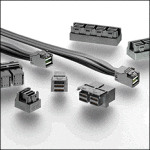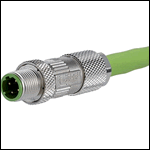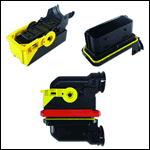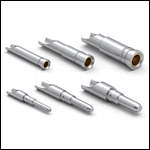The Evolution of Heavy Duty Connectors
At one time, aluminum was the primary material option for heavy-duty connectors, but now plastic is a reliable and viable option.
Over the years heavy-duty connectors have evolved from clunky pieces of heavy metal with contacts to robust, lightweight connectors that can mate with products from other manufacturers. They are also capable of routing signal, data, power, and pneumatics in a single housing through an enclosure wall, and they can utilize adapters that allow the connector’s cable to run through plastic corrugated tubing that meets a high ingress protection (IP) rating of IP69k.
Changes in the Heavy-Duty Connector World
At one time, aluminum was the primary material option for heavy-duty connectors, but today, plastic can be a reliable and viable option. Plastic connectors typically cost less to manufacture than metal. The lower material cost for the manufacturer can result in a lower-priced connector for the user. In addition, plastic’s lighter weight reduces shipping costs.
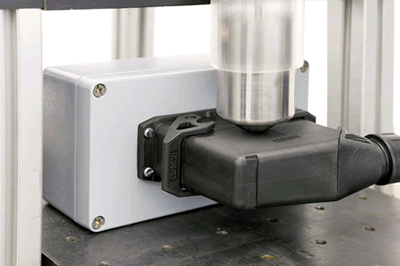
Heavy-duty plastic connectors must meet the same IK08 high-vibration and shock tests that aluminum connectors have been subjected to.
Meeting the shock resistance test requirements of IK08 is essential for high-vibration or -shock applications. Today, heavy-duty plastic connectors can meet the same IK08 requirement as aluminum connectors. Some connector suppliers have gone a step further and subjected their plastic connectors to a roll-over test according to DIN IEC 32196-1. This test is carried out by rolling a forklift weighing several tons over the housing.
In cases where shielding the connector is a concern, the housings typically are constructed of die-cast aluminum. This prevents noise or EMC from propagating onto the cable lines. The user must be careful to purchase a cable gland that offers the same EMC protection as the connector’s housing.
Some metal housings can be used in locations where saltwater misting is present (offshore wind turbines, for example). In general industrial applications such as material handling or machine tooling, these same housings can also be used. This flexibility can reduce the overall inventory that a user needs to stock, again helping to reduce costs.
Because the heavy-duty connector has been around for some time, there are requirements that cannot change. Connectors need to be compatible with “legacy” products still installed in customers’ machines and systems. The panel cut-out dimensions will be the same from manufacturer to manufacturer for similarly sized housings and will use standard industry punches. New contact inserts need to be compatible not only with the legacy products, but in some cases, also with similarly sized products from another manufacturer.
There have been a number of advancements with the contact inserts over the years. Both fixed-position and modular insert designs can meet the higher current or voltage demands that today’s customers require. Some fixed inserts can handle up to 80A, with modular inserts capable of handling up to 200A. Most voltage ratings will be the normal UL 600V level, with some rated 1000V or higher.
Connection Technology Options
Manufacturers have also made new connection technology available in contact inserts, including the popular push-in style. The push-in connections help cut down on wiring time and save labor costs. Push-in connectors will accept solid or ferruled stranded wires. Screw connection is still the most popular connection technique in many industries, but the push-in style is slowly gaining traction as users realize the assembly costs and time savings.
Of course no matter what connection technology the contact inserts use, the housings need to be designed to accept both fixed or modular contact inserts. This practice is another way customers can reduce stock levels and lower inventory costs.
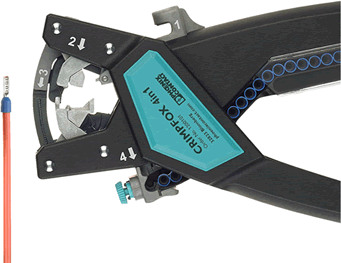
Phoenix Contact’s Crimpfox 4-in-1 can cut, strip, twist, and crimp a ferrule onto a 20-14AWG wire.
Crimp connection technology is still the leader for applications that require high-density connections. Some applications can require up to 216 connections. In cases like this, the right crimping tool can greatly simplify the job. Connector manufacturers now offer automatic crimping machines to speed up this process. For applications with lower density requirements, the right hand tool can streamline the job. An all-in-one crimper that cuts, strips, twists, and crimps ferrule onto a wire can be up to 30% faster than using multiple tools to perform the steps.
Don’t overlook the cable
Of course, you always have to connect the cable to the heavy-duty rectangular connector, but one item that sometimes gets over looked is the cable gland. The cable type needs to be determined well in advance of initial design. Will it be a jacketed cable or multi-conductor type?
In some instances, designs will require the use of flexible or rigid conduit, so an adapter for National Pipe Thread (NPT) will be needed. There are a number of gland designs available that will allow the user to connect the conduit to be more flexible and to accept multiple wires while still meeting local safety codes. Some manufacturers have developed unique adapters that allow plastic, liquid-tight, and air-tight conduit to thread into the connector housing. These adapters must meet a high ingress protection rating of IP66, IP68, or even IP69k, which is now attainable. The flexible plastic conduit will be resistant to oil and to some acids and solvents. Other applications, such as the rail or transit industry, require plastic conduit that is UV-resistant and also free of silicone, halogen, and cadmium.
This marriage of conduit to the heavy-duty connector allows suppliers to offer a complete connection package for every unique application.
Author Steven Obert is product marketing lead specialist for industrial field connectivity at Phoenix Contact USA in Harrisburg, Pa.

